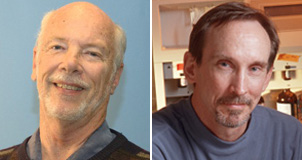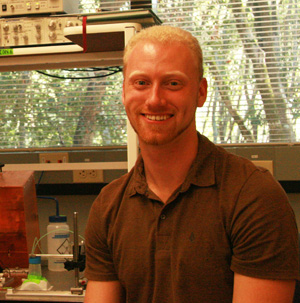For more than 15 years, researchers at the University of California, Santa Cruz, have been developing technology to analyze DNA strands as they pass through a tiny pore in a membrane, called a "nanopore" because it is just 1.5 nanometers wide at its narrowest point. Now, Oxford Nanopore Technologies of Oxford, U.K., has announced plans to market the first commercial DNA sequencer based on this nanopore technology.
Genetic information is encoded in the sequence of nucleotide subunits in DNA molecules. Scientists have devised many different methods for DNA sequencing, which has become progressively faster and less expensive in recent years. Nanopore sequencing has the potential to become one of the fastest and cheapest approaches yet.
Oxford Nanopore, established in 2005, has license agreements with UC Santa Cruz and other leading institutions in nanopore science, including Harvard University and Boston University. Biomolecular engineers Mark Akeson and David Deamer, who serve on the company's technology advisory board, established the nanopore research group at UC Santa Cruz in 1996.
"Oxford Nanopore is the only company that took our ideas seriously," said Deamer, a research professor of biomolecular engineering in the Baskin School of Engineering at UCSC. "It's pretty amazing to see this technology turned into a real commercial device."
Clive Brown, chief technology officer at Oxford Nanopore, presented DNA sequence data from the company's nanopore devices at the Advances in Genome Biology and Technology (AGBT) conference in Marco Island, Florida, on Friday, February 17. The company said it plans to market its devices directly to customers in 2012, including a miniaturized device it describes as "a disposable DNA sequencing device the size of a USB memory stick whose low cost, portability and ease of use is designed to make DNA sequencing universally accessible."
"We're delighted at this latest success in commercializing UCSC faculty research," said Bruce Margon, vice chancellor for research at UCSC. "An important part of the university mission is not simply education of students and creation of knowledge, but also where possible moving results of that research out into the community where it can benefit society and create positive economic impact. This is a great example."
Deamer first came up with the idea for nanopore sequencing in 1989 when he was at UC Davis. He had done postdoctoral research at UC Berkeley with Daniel Branton (now at Harvard), and they worked on the nanopore idea together, beginning in 1991, and published their first paper in 1996. Deamer and Branton collaborated until 2005 before pursuing different directions in nanopore research.
Akeson, now professor and chair of the Biomolecular Engineering Department, leads the UCSC nanopore group, which has made important advances in nanopore sequencing technology. The group uses a nanopore formed by a self-assembling protein complex called an ion channel, inserted into a membrane similar to a cell membrane. The membrane separates two wells, and an electric field drives DNA strands (which are negatively charged) from one well to the other through the nanopore. The brief blockage of the nanopore by the DNA strands as they pass through the pore produces electrical current modulations that can be analyzed to yield DNA sequence information.
One of the big challenges has been controlling the movement of the DNA through the nanopore. With an unconstrained DNA strand, each subunit (called a nucleotide) zips through the pore in about three microseconds, too fast to get an accurate reading. Akeson's group has focused on the use of enzymes that bind to the DNA to control its movement through the nanopore. A paper presenting their latest results was published in Nature Biotechnology on February 14. The first author of the paper, Gerald Cherf, began working on the project as a UCSC undergraduate and is now a junior specialist in Akeson's lab.
"We've taken a natural enzyme that can move the DNA with precision and coupled that to the nanopore. It's doable with a variety of enzymes and is very successful," Akeson said. "Oxford Nanopore has taken that basic approach and improved on it in ways to make it commercially viable."
The UCSC nanopore group has been funded primarily by grants from the National Human Genome Research Institute (NHGRI), with additional funding from Oxford Nanopore Technologies.





